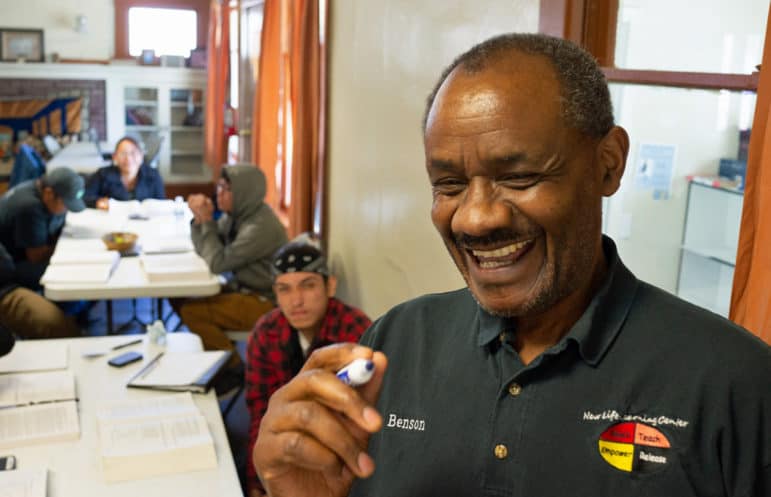
Don Usner / Searchlight New Mexico
Benson Ndolo, executive director of the New Life Learning Center, teaches students math, grammar and the other subjects they’ll face on the GED test.
GAMERCO, NM — Jamie Eddy, 24, arrives early at the house on Chino Street on the edge of the Navajo Nation and picks the spot where she’ll spend the day: at a foldout table in a foldout chair, with a 974-page GED study guide in front of her.
She opens her notebook and her 6-year-old son grins out from a photo pasted on the inside. “I’m here for him,” says Eddy, one of 20 students to sign up for the free prep course. “I want to be a good role model for my son and for my family.”
It’s a common sentiment at New Life Learning Center, an otherwise uncommon place. The aging wood-frame house in Gamerco, north of Gallup, is one of the few nonprofits of its kind on or near the Navajo Nation, a 27,000-square-mile swath of New Mexico, Utah and Arizona.
The teacher and executive director, Benson Ndolo, 58, is a native Kenyan with a lilting accent and boundless optimism. Ndolo has spent more than 10 years working in Navajo communities, helping people get a “general education” (GED) high school diploma and running ESL classes, youth groups and other programs.
He’s also a pastor: On Sundays he preaches to a small group of regulars who sing spirituals in Navajo, English, Spanish and Swahili.
Ndolo’s students, most of them Navajo, have grown up under the most difficult circumstances. Up to 40 percent of Navajo households — as many as 54,000 people — have no running water, federal reports say. They have no safe drinkable water from a tap; no clean water to wash hands, cook food, shower or wash clothes.
Some students grew up sleeping on blankets on the floor, in ramshackle houses shared with 13 or more relatives. Many people drive for miles to haul water; some get their supply from unregulated wells or livestock tanks that can be contaminated with fecal matter, bacteria, viruses, uranium or arsenic.
A high school equivalency diploma represents a milestone for any graduate. But at the house in Gamerco, students say it represents something much larger. They want their GED to help their children lead better lives and lift the entire family.
That’s Ndolo’s goal, as well. “Come on, guys,’ he exhorts. “Don’t think, ‘Oh no, I’m from the rez, I can’t do it, I’m just from Gamerco.’ No! Don’t think inside Gamerco. Be thinking outside. Think big!”
Eddy, who dropped out of ninth grade when she became pregnant, enrolled in part to honor the memory of her mother, who died recently of alcohol-related causes. “I miss her so much,” she says. “My being here would make her happy.”
She also is here to support her brother Nathaniel. On a recent day he comes in late, his shoulders hunched in exhaustion, face hidden in a gray hoodie. He occasionally jots answers to Ndolo’s grammar questions on a crumpled piece of paper, but he never volunteers an answer.
“I haven’t been the same since my mom died,” Nathaniel, 18, says, when pressed. “I don’t feel like talking.”
It’s not easy for anyone to sit on a hard chair from 9 a.m. to 3 p.m. three days a week for months, driving up to 30 miles to stare at reflexive pronouns. It’s especially hard for those who live on the Navajo Nation. Of its 14,220 miles of roadways, more than 75 percent are unpaved dirt, rock and washboard, with potholes that could swallow a wheel. Rain and snow can turn them into gumbo.
Few of the students can afford cars. They take buses, beg rides or sometimes hitchhike to the class in Gamerco. Most of them are parents who have to arrange childcare. People with jobs sacrifice their work hours to show up.
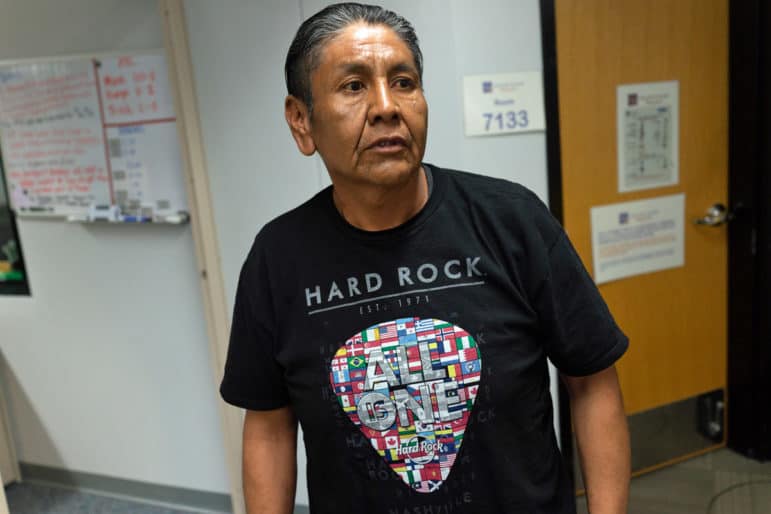
Don Usner / Searchlight New Mexico
Gerold Yazzie, a contractor, after taking his GED test in April: “I need my diploma to move ahead in life,” he says.
“Benson is a real nice man. He makes you feel comfortable,” offers Gerold Yazzie, 40, a contractor from Window Rock, 25 miles north.
“It’s inspiring to be here,” says Shalylah Carmona, 19. “It feels like home.”
‘We need to be proud’
In the traditional sense, home on the Navajo Nation is the ancestral land within the boundaries of the four sacred mountains. It is a 16-million-acre palette of high plains and plateaus, mesas and desert, piñon and juniper. The reservation is the largest in the country — the size of West Virginia, but with only 170,000 residents.
The Diné (“the people,” in Navajo) were forced by the U.S. military to leave their homeland on the Long Walk, a 300-mile march and subsequent internment that killed thousands. An 1868 treaty allowed them to return home. But the pact didn’t prevent U.S. government policies from shattering families, culture, tradition, language, health, the environment and the economy.
The Navajo Nation today has some of the country’s highest rates of child poverty, joblessness, alcohol-related deaths, youth suicide and diabetes. High school dropout rates are as high as 40 percent.
The grim statistics are no secret. The outside world constantly publicizes the tragic stories, leaving out the Navajo history of strength and perseverance. Children grow up feeling hopeless under the barrage.
“It’s important to build on the strengths and resilience all around us,” says Gloria Begay, 67, a Navajo educator, health advocate and community activist of 40 years. “We need to be proud of who we are, proud to be here, proud to be survivors. It’s surviving that makes us stronger.”
Begay knows about perseverance. In the 1980s she was appointed to the National Advisory Council on Indian Education. She worked in Washington, D.C, directing Indian education programs in the U.S. Department of Education and other agencies. She traveled to China to attend the United Nations World Conference on Women. In 2014, with her help, the Navajo Nation passed a tax on junk food, the first of its kind in the country.
Today, she’s leading a grassroots effort to create board games that teach children the Navajo language, culture, values and traditions. She’s part of the Diné Food Sovereignty Alliance, campaigning to bring healthy, traditional foods back to the reservation.
But even for Begay, staying positive isn’t always possible.
“People ask why the diabetes rate here is so high? It’s not just about the food,” she says on a recent day. “We have the highest rates of stress and worry. All of us, every Navajo, is affected by at least one of these things: lack of water, food, jobs, education, paved roads, electricity or a home.”
One day this winter, she ran into an old friend – a former newspaper reporter — at the Gallup public library. “He asked me to drive him home,” she says. “He was living in a 10-by-5 storage unit.
“I tell people in government about things like this and they can’t believe it. I say to them, ‘You guys are all bug-eyed at the statistics about no water and no electricity? Why don’t I take you home and you can see for yourself? Come on down the dirt roads with us and see it!”
Do they come?
“No.”
‘This is America?’
If they did come, this is what they would see:
As many as 15,000 Navajo homes — roughly 30 percent of the total — have no electricity.
A recent article in the Navajo-Hopi Observer described how an 88-year-old woman turned on a lightbulb in her kitchen for the first time — in 2017.
“Energy poverty” — the federal government’s name for no electricity — hurts children most. Mothers without lights don’t read to their children at bedtime; kids fall behind in school because they can’t do homework after nightfall. No phone service means parents can’t call an ambulance, fire department or police. Families lack electricity to keep warm.
They too often also lack water. Many families here live on fewer than 10 gallons a day, a 10th of what the average American family uses. The lack of safe water has some of the same consequences as in Sub-Saharan Africa, including a high rate of severe diarrhea, a dangerous illness for children younger than 5.
Ndolo, who arrived in the U.S. in 2000, was shocked when he first set his eyes on Indian Country. “I saw dirt roads and no water on the Navajo reservation. It looked just like parts of my own country. And I thought, ‘This is America?’”
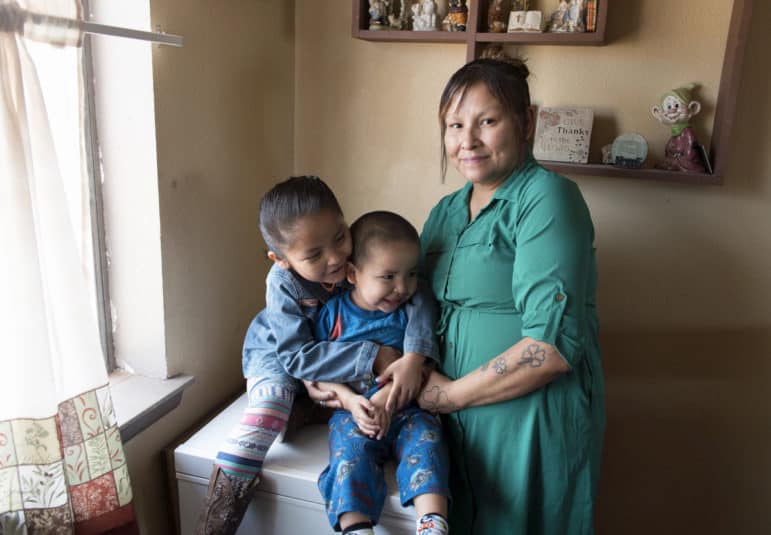
Don Usner / Searchlight New Mexico
Kadence, Nicholas and Lisa Lee, at home.
Breaking the cycle
Lisa Lee, who dropped out of ninth grade, arrives at the New Life Learning Center one recent day with her two youngest sons, age 2 and 3, and her 16-year-old niece in tow.
Lee, 38, knows the house well. It’s where she got her GED two years ago. Back then, she was so shy she was barely able to speak. Ndolo kept pushing her. “He always wanted me to speak out,” she says. “And it worked. Now I can speak in front of a whole church full of people.”
On this particular day, she’s here to sign her niece up for a GED course. Like Lee, the girl dropped out of high school and got caught up in drugs.
Lee has taken her under her wing and welcomed her into the tidy, three-bedroom tract house she shares with her husband, their six children and her husband’s nephew.
Lee, the youngest of 11 children, grew up in a three-room house in Vanderwagen, 18 miles south of Gallup. There was an outhouse and no running water. The kids slept in one room on the floor.
Every day after school, her father drove her and her siblings to Earl’s Restaurant in downtown Gallup, where they sat outside until dark, selling their homemade jewelry. Sometimes they’d sneak off to a nearby Long John Silver’s and buy crumbs — bits of fish off the grill — for 25 cents.
“I was rejected and not loved,” Lee says flatly. “And I was molested. And I was raped. And I was abused a lot. And as I grew, you know, I really didn’t have that love.”
For years, she says she used drugs, drank and gambled.
Life might have gone on that way. But in 2015, her youngest child got sick and ended up in intensive care in Albuquerque.
“I turned to the Lord for help,” Lee says.
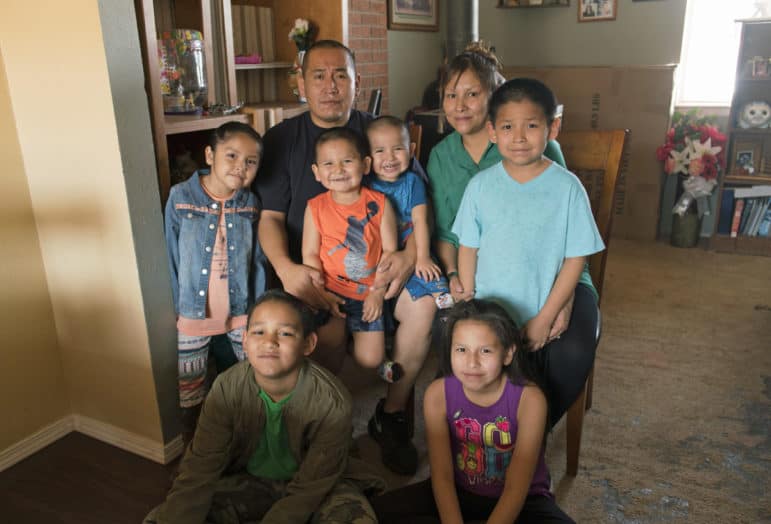
Don Usner / Searchlight New Mexico
The Lee family at their home on the Navajo Nation, in Window Rock, Ariz.: From left to right, top row, Brendan Lee and Lisa Lee; middle row, Kadence, Bruce, Nicholas and Xavier; bottom row, Zachary and Dominique.
Embracing Navajo tradition is how other parents across the Navajo Nation guide and protect their children. The traditional way of life – the Diné language, culture and values — provides a foundation for children’s health and well-being. Tradition gives children a sense of identity and connection to their past and their future, something reinforced by fundamentals like K’e, or kinship, which makes family relationships central to their lives.
Lee’s roadmap is her fierce belief in Christianity.
She got sober. She got her GED. She convinced her then-fiancé to convert. And he enrolled at the University of New Mexico in Gallup; he’s due to graduate in May.
“We’re doing it for our kids,” Lee says.
Support far away
“Good morning! Good morning!” Ndolo announces to the class of 13 students. “You made it! We’re going to have a good time today!”
He walks slowly around the room and shakes hands with students.
“Jamie,” he says, when he sees a large gauze bandage on hers. “What happened to your hand?”
“I burned it,” she says, embarrassed. “I was cooking bacon. The handle on the pan broke.”
“And you still came to class! Good for you!” Benson exclaims. “Many other people, you know, they’d say ‘Oh, Benson, I can’t come because of the bacon. Oh, Benson, since my bacon I can’t do anything.’ But no, you don’t use excuses.”
Classes at New Life Learning Center are free, aside from a small registration fee that Ndolo says he imposed because students are less likely to drop out if they’ve invested something. The only financial burden is the $120 fee that the GED Testing Service charges — double the price of a few years ago, and beyond the means of many students.
Nearly 500 of Ndolo’s students have earned their high school equivalency degree in the last four years, by his count. The center was voted “Program of the Year 2011-2012” by the New Mexico Coalition for Literacy.
But the financial picture is bleak, Ndolo says. The center’s main support has been a foundation in the Netherlands that funds humanitarian programs around the world; that grant ran out last year. McKinley County gave the New Life Learning Center a few thousand dollars in 2016, about $9,000 less than in previous years, owing to budget shortfalls.
The worst news came in late March, when the center was informed that it could no longer offer GED tests. Ndolo’s students will have to travel to GED testing centers miles away, a difficult prospect.
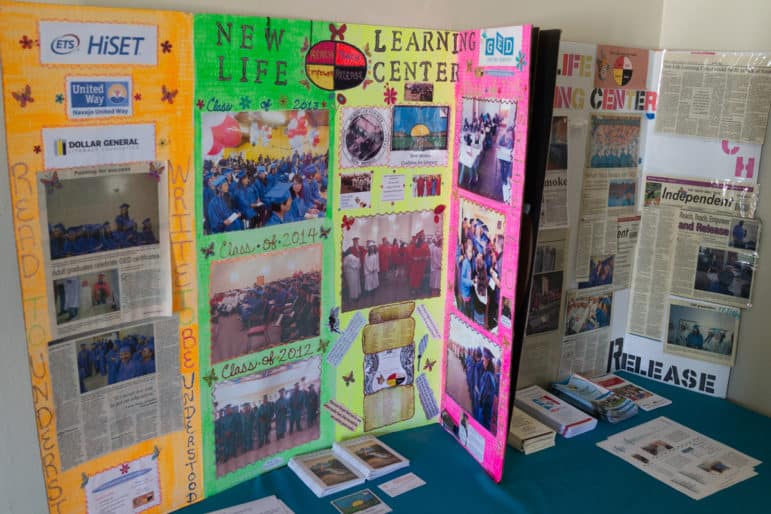
Don Usner / Searchlight New Mexico
Students don caps and gowns for GED graduation ceremonies; a display at the learning center shows the news coverage.
Things will work out, Ndolo tells himself. All that matters for the moment is his students and their warm-up exercises with pronouns. Ndolo asks people to read a sentence with “I” or “you.”
“I feel content today,” a woman named April says.
“Every time I go out with my son, I tell him to behave himself,” Jamie Eddy says.
Ndolo’s eyes travel to Jamie’s brother, Nathaniel.
“Nathaniel, what have you got?”
Nathaniel Eddy glances up briefly before returning his gaze to the table, his entire body begging Ndolo to leave him alone.
“I don’t have a sentence,” he says.
“That’s okay. Give me anything,” Ndolo says.
“I guess I have one,” Nathaniel says with a shrug. “It ain’t that good, though.”
He stares at his paper and mumbles: “You and your friend went to the arcade, but your friend wanted to leave and you didn’t.”
Ndolo whoops. “Can you imagine he was keeping all that treasure to himself?” he exclaims. “Oh, that’s a great sentence! That’s one of the best sentences we’ve heard in the whole class! It’s a long one, too. Come on, Nathaniel — this is what I’m talking about! Give him some applause,” he tells the class.
Everyone is already clapping.
Searchlight New Mexico is a nonprofit nonpartisan organization dedicated to investigative journalism. Read more of our stories on Raising New Mexico at projects.searchlightnm.com.